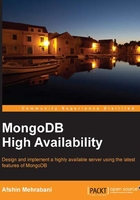
Conventions
In this book, you will find a number of styles of text that distinguish between different kinds of information. Here are some examples of these styles, and an explanation of their meaning.
Code words in text, database table names, folder names, filenames, file extensions, pathnames, dummy URLs, user input, and Twitter handles are shown as follows: "In the MongoDB structure, the mongo file is responsible for this task."
A block of code is set as follows:
{
"_id": ObjectId("725c211a412f812548cv3258"),
"data": 1
}
Any command-line input or output is written as follows:
-f (file size): unlimited -t (cpu time): unlimited -v (virtual memory): unlimited -n (open files): 64000 -m (memory size): unlimited -u (processes/threads): 32000
New terms and important words are shown in bold. Words that you see on the screen, in menus or dialog boxes for example, appear in the text like this: "MMS supports all types of MongoDB instances, including Sharded Cluster, Standalone, Replica Set, and Master/Slave."